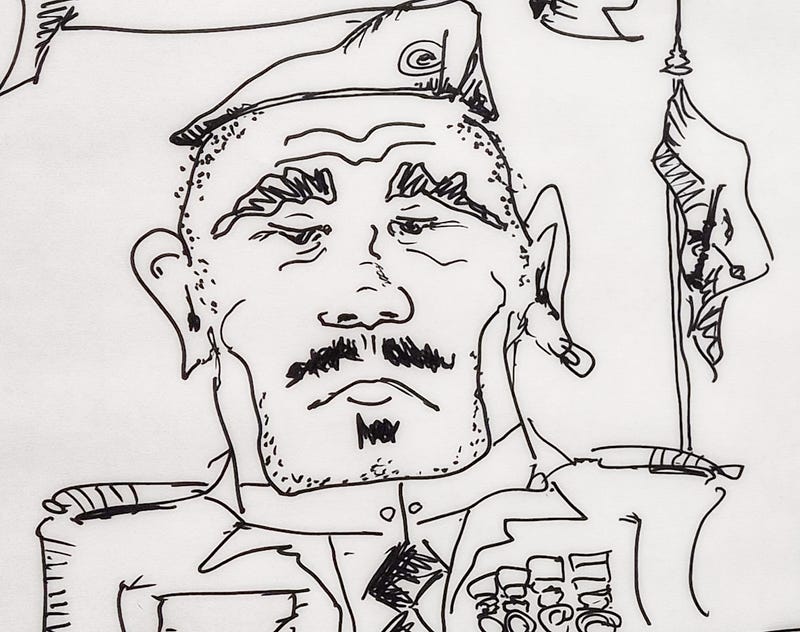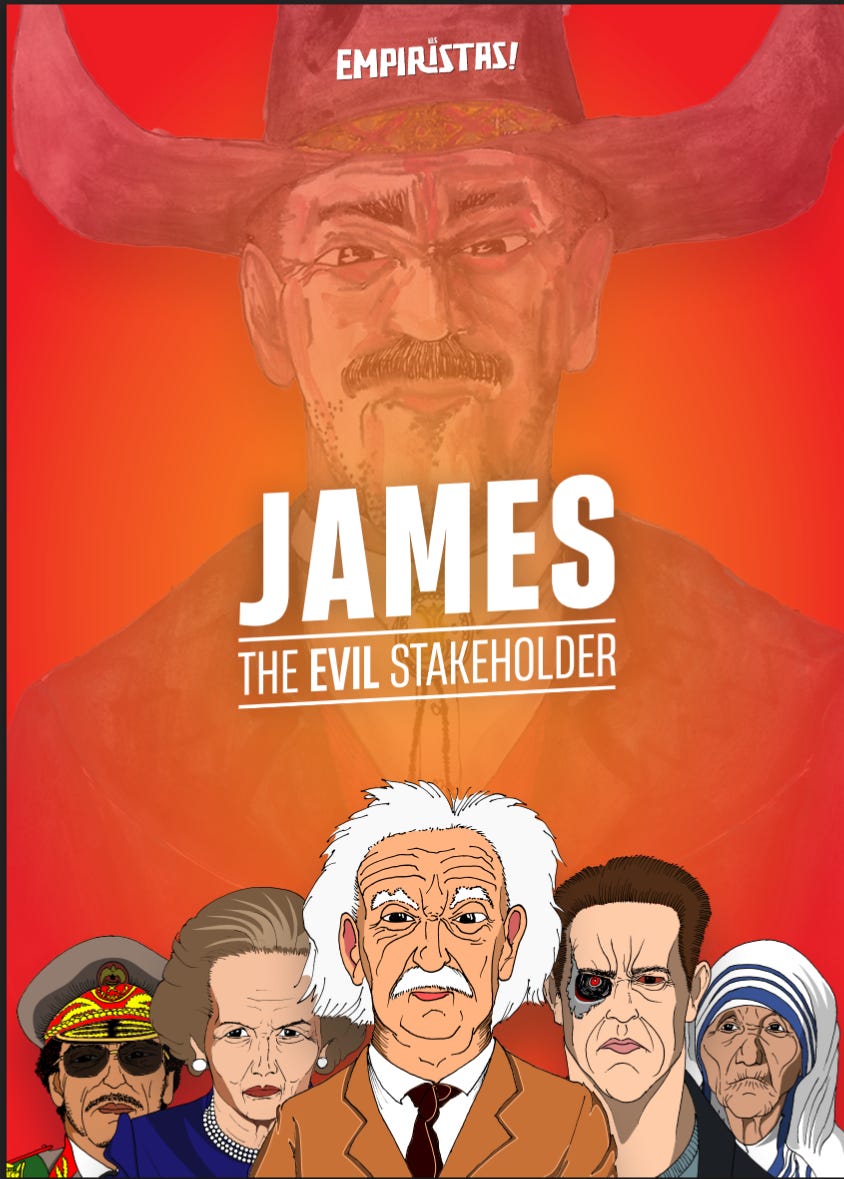James The Evil Stakeholder™ - from Idea to Product
How a training exercise sparked a surprising entrepreneurial journey
“Sooooo, government officials don’t care about money. As long as they get what they need. They have more important things to think about. So we can basically charge whatever we want.”
“True, but they do have to track their spending. And can get into a lot of trouble for it…”
“Aah, so what we need are government officials who are free from scrutiny. Like dictators! They not only don’t care about money, they are swimming in it!”
Towards the end of 2023, Bas Klinkhamer and I participated in a Professional Scrum Product Owner Advanced training.
To make the training more engaging, the group was divided into teams and each given a business case to develop during the course. The business case serves as the focus for all the exercises during the course.
Ours was “to develop a business plan based on supplying transportation services to government officials”. The conversation above is the moment when our business plan began to seriously go sideways, at least in an ethical sense.
“Not to worry, it’s only an exercise.”, said Chee Hong Xsia, our trainer. “If it makes for a sound business plan and makes the course more fun - go for it!”
That was all the encouragement we needed. The stage was set.
Through various exercises, we gradually developed our business plan, working on things like our vision and roadmap, pricing, and marketing strategy.
One of the exercises was to create a persona for our target customer. This was the moment His Excellency Earl James The Third, a.k.a. James the Evil Stakeholder™, was born. A government official (read - dictator), with a focus on discreteness (read — avoid scrutiny) and security (read — avoid being whacked), and not interested in the cost as long as the service is reliable (read — will whack us if we fail).
Introducing James — The Evil Stakeholder™
The James was born out of a moment of learning, but one we insisted should also be a moment of fun. Lots of fun. Which perfectly illustrates how innovation doesn’t come from forcing it, but from letting go and trusting in serendipity.
In fact, Bas and I never really entertained the idea of doing anything with The James. For us, he was just about enjoying the training (and testing the limits of our dark sense of humour), and that was enough. It was Chee Hong who kept pushing us to do something with him.
Initially, we thought about using him to create a LinkedIn personality to say nasty, anti-Agile things. But we felt the potential for misunderstandings and getting into serious trouble with this was high.
Eventually, we homed in on The James’ personality and its effect on others.
Most of us have had the pleasure of working with a James in our lives. They are that domineering CEO who doesn’t trust his employees and micromanages everything, making everyone’s life tedious. They are that arrogant Architect who insists their plans are perfect and makes sure they are the only one who can approve merge requests. They are that IT Manager who insist on managing tooling because they think they are the only one smart enough to do it.
It is surprising that dealing with these kinds of people does not get a lot of scrutiny. And definitely not from the perspective of the team. It fits in a wider pattern: while it seems every aspect of the team itself has in one way or another been covered, the environment the team operates in, from stakeholders to the way the organisation itself is organised around the team, are usually ignored. Surprising, considering how much impact these things have on the effectiveness of a team and how prevalent a problem they are.
Clearly, an interesting gap in the market. Instead of focusing on the nasty things The James does, why not focus on how to deal with him? An untapped market opportunity!
The James Personas
A violent dictator was perhaps a bit extreme for that perspective so we got down to brainstorm other possibilities, eventually settling for a domineering capitalist, inspired by J.R. from Dallas, that old soap series from the 80’s.
And with that we became aware of the idea of using archetypes to make the evil deeds of stakeholders come to life, inspiring us to think about what other archetypes we could uncover. This led to a total of 6 James characters: James the capitalist, Einstein as the subject matter expert, The Terminator as the process freak who wants to perfect everything, Teresa as the zealous preacher, Thatcher as the cunning politician, and finally, Gadaffi, the dictator. Yes, indeed, coming back full circle to the original dictator! But now safer, as just another stakeholder archetype.

The Gameplay
The brainstorming part of the cards, with the goal of helping teams learn to deal with difficult stakeholders, was pretty straight forward. We created James Cards describing a number of typical difficult stakeholder use cases, such as:
“The James has a genius idea. And he has a genius approach to get it done in no time. He has the full scope defined as detailed requirements, a deadline and a budget for ya. The only thing you need to do is write the user stories and get cracking!”
And we created Response Cards, for which we collected a variety of techniques and responses a team could use to deal with The James use case.
A team exploring how to deal with The James simply draws a James Card. They then each draw Response Cards and discuss as a team the best response. The whole idea focuses on the discussion to decide on the best response.
But Bas and I are nothing if not ambitious, and so we decided we also wanted to offer something more: a regular card game for teams to play. Perhaps as a counterweight to the heavy discussion, or perhaps because we felt sad that the game would only be used for retrospectives.
So that was the next piece of the puzzle: a real card gameplay, one you could just play at a bar with friends and no idea of work or stakeholders. It turned out to be the hardest thing we did for the whole product. Ironic, considering that it was more of an easter egg.
Testing the Product
With the goal clear we were ready for our first prototype to test our ideas, just to make sure we were not deluding ourselves. Nothing is more motivating than having to put your own hard-earned money on the line: constraints fuel innovation.
At the time, Bas had been busy creating an online estimation poker tool. Which he handily modified to create the first online version of The James game, complete with our own artwork. We invited 3 friends, 2 Scrum Masters and a Developer, to try it out, people we could trust to be forthright and with enough experience to give us valuable feedback.
The positive responses to this first tryout were very encouraging. It gave us the confidence to go for a real set of cards. Also because we found that our testers were rather distracted from the game by the online experience itself. Budget solutions have their drawbacks.
After incorporating the feedback we got to refine the game, we ordered 5 sets of cards for our next step: playing the game for real, at the SF Original Conference, where we presented the game as a workshop.
Never ready to waste an opportunity to have some fun, we came up with a gig to pitch our session involving me dressing up as The James and browbeating my ‘useless assistant’ Bas (think Dracula and Renfield). Great fun but it wrecked our nerves, and we were woefully unprepared for the workshop itself. I completely messed up the intro (which Bas was supposed to do) and we were continuously improvising, rushing to fix things we never thought to prepare.
Even so, and perhaps in part because of it, the reception was amazing. Later, discussing the feedback and the experience, Bas and I discovered that we had independently come up with similar metrics to measure success:
the amount and quality of laughter (people falling into uncontrollable fits),
a deep recognition of the cases described in The James’ cards (serious and deep discussions).
Our participants contributed one more — our dark humour verging on the edge of unacceptable political incorrectness. Without really realising it, we had channeled a rebellious streak that was very much appreciated. Another vindication that we really had something in our hands. It was an absolutely brilliant experience. Mission accomplished!

Feedback from that conference led to a new improved set of cards. This time we ordered 6 sets for our next conference, the XP-Days Benelux Conference in Belgium. Which turned out to be another brilliant success.
Conclusion
It is an interesting aspect of this whole experience, that things seem to just happen, one thing leading to the next. Bas and I are both professional Agilists, but we never set up any kind of process for what we were doing. We both intuitively knew what needed to be done and trusted each other implicitly.
Repeatedly, I would think of something that needed to be done, only to get a message from Bas that he’d picked it up. And I’m sure the same happened to him [yes, the same happened to me! True story! — Bas]. It illustrates that while processes are useful, motivation and trust are far more effective alternatives to managing work. There is no need for control when everything is under control.
We also intuitively played to our strengths. Bas got us going in the beginning, because I’m terrible at taking that first step. I got that first drawing of The James done, which really helped to make things concrete. But it was Bas’ enthusiasm that pushed me to draw more Jameses. Not everyone is equal in a team, and that is a good thing, because differences help towards synergy and serendipity.
Deadlines also helped immensely. Getting the cards ready for the conferences was a crystal clear endeavour because both times we ended up getting everything done at the last possible minute (we picked up the second set of cards on the way to Belgium!), it lent a sense of urgency that was exhilarating and made our focus razor sharp.
As I write these lines, Bas and I are preparing the first production run of The James. We have a small kanban board (our first process!) on mural and we’re already shaping ideas for other games, as well as workshops to help organisations more directly.
We created a company to do the sales and manage the product. We’re experimenting with our own version of Holacracy and are working on press-ganging a good friend to become our third partner in the company. Three is always better than two when it comes to stable leadership.
Fundamentally, this whole experience confirms the idea that true agility has nothing to do with processes and frameworks and complicated techniques. Instead, it is about creativity, enjoyment, and collaboration - the human factor.
A clear goal and trust in each other leads to a visceral almost unconscious sense of Flow, where what needs to be done is obvious and the natural thing to do. Fuck ups are part of the game, to learn from and have a laugh at how well (or badly) we deal with it. All fueled by creativity and the basic eagerness to do fun stuff and a complete lack of fear. Without realising it or planning it, we have both become entrepreneurs. And It all started with a fun training! Our trainer would be proud of how far we’ve come.





